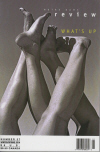Notre Dame Review – Winter/Spring 2014
“What’s Up?” is the title of this issue; on Robert Kareka’s cover, “Muddy Feet” are up, waving around in beachy air. But a lot more is up, too. Most of the time, the appeal of literature is its pointing beyond itself, like a Zen finger, to the “world under the world.” Language’s gaps and leaps, the cumulative sound and meaning of particular arrangements of words, lead us past mere materiality into the reality behind it, so that we close the pages transported and enlarged, though we couldn’t put our finger on the exact paragraph that did the trick.
“What’s Up?” is the title of this issue; on Robert Kareka’s cover, “Muddy Feet” are up, waving around in beachy air. But a lot more is up, too. Most of the time, the appeal of literature is its pointing beyond itself, like a Zen finger, to the “world under the world.” Language’s gaps and leaps, the cumulative sound and meaning of particular arrangements of words, lead us past mere materiality into the reality behind it, so that we close the pages transported and enlarged, though we couldn’t put our finger on the exact paragraph that did the trick.
John J. Clayton’s short story “Whispers” chooses not merely to hint at that reality. Instead, the extra-material world assaults Peter Weintraub, the story’s protagonist, in the form of voices under voices, knowledge behind facades, distressingly direct and accurate. Peter sees his doctor, gets pills, talks to his wife without disclosing the real issue. He knows, through his unasked-for awareness, what troubles his boss, who has never exactly been his friend. Peter extends compassion. There is no solution—the trouble doesn’t disappear, and neither do the voices. Direct access to voices, to “what’s up,” is worrisome. It’s not easy or peaceful. But compassion matters—to Peter’s boss, to Peter, and to us. What’s up in this story is grace, complicated, hard to share, but unmistakable.
When Weintraub is trying to explain his strange behavior to his wife, he says, “There’s a world under the world. Everything is connected.” She is naturally concerned by his mystical testimony, uncalled for and unexplained as it is. Earlier in the magazine, Brian Swann’s prose poem “The Net of Indra” echoes (or presages) the mystery. Indra’s net is a metaphor in Mahayana Buddhism: hanging over the palace of the Vedic god at the nexus of the universe, it bears a brilliant jewel in each node. Every jewel reflects every other jewel. Of course Weintraub can sense what others are feeling, for he is a node in that net, reflecting. Swann’s poem connects a petroglyph, a bird, shards of light, “kaleidoscope of shivers like rain, a spectrum where the marble feet of the cold walk up to the window and daylight comes . . .” Its form mirrors its meaning, or makes it—everything is everything else, of course, of course.
So what’s up in this issue is the poignant whimsy of probably-not-so-random chance, the longing for understanding in a life that transcends such a simplistic goal. Rumit Pancholi’s poem “Bifurcate at L’Enfant” places its speakers (and us) at a crossroads—the first-date crossroads of courtesy and sharing, “The trips we’d long / to take, those we’ve taken but ache to repurpose // with a loved one,” a series of linked and lingering couplets whose images tremble like the nodes of Indra’s net with the reflection of what might happen, what might have been.
Todd Davis’s “Drouth” flings dead fish on a desiccated cornfield in the wild hope that they’ll bring rain: “Soon the dark light farther down began to fade. Fish lost / the paths they followed in the weeds, bodies floating to the top / where we skimmed them to scatter in the fields.” The tragedy feels beautiful in the mouth, the “drouth” a wellspring for language if not for luck with crops.
Douglas Silver’s opening story, “Oklahoma City,” has as many subplots as a short novel; the sixth-grader protagonist is bullied until the Oklahoma City bombing, when a misunderstanding leads everyone suddenly to treat him normally for a short, sweet time. In Corinne Demas’s “The Clock,” the gulf between rich and not-so-rich widens and then clinches, like a wince. What the rich fiancée hopes her less-wealthy beau will not notice does not, after all, escape his view, and he breathes a surprised sigh of relief that the loss of her is inevitable.
Michael Perkins’s memoir “Beats and Bronk” dishes up a duo of curiosities, first that a party full of Beat-era celebs could be boring, and second, that a “master spirit” could be such a dear and wonderful friend. Greatness mingles with intimacy in random inconsistency.
Surprise, then, is what’s up—but a sort of inescapable revelation, unquestionable once out in the open. Even the reviews that finish up this issue of NDR assure us that what’s up is both wondrous and everyday, slippery and undeniable. Poetry—its music, its Jewish techno-modernity, its role in the contemporary world—and Bret Lott’s memoir, about whose Christianity the reviewer is ambivalent, are illuminated with clarity and intelligence, as are the several volumes reviewed briefly in the concluding “Editors Select” section. Despite numerous minor typographical and editing slips (words left out, apostrophes missing), this issue of NDR deserves close attention. Everyone ought to know what’s up.
[ndreview.nd.edu]





